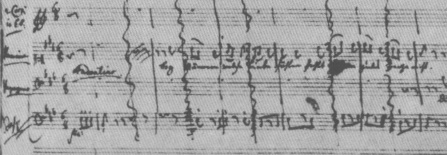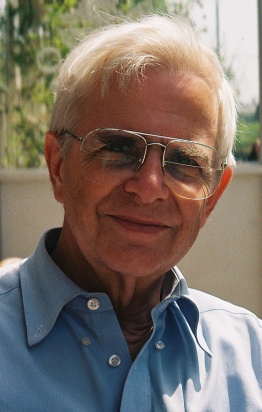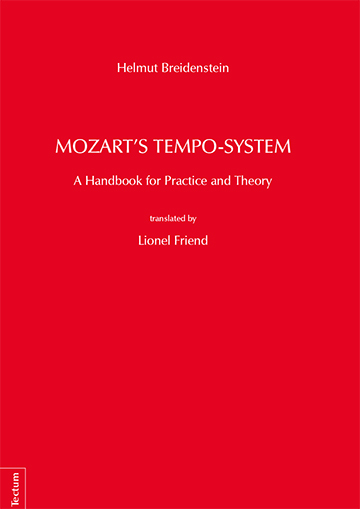| Mozart´s Tempo-System |  |
| home | deutsch | français | italiano | footnotes | music & diagrams | tempo indications | metronome | literature | impressum |
This question which so many authors have tried to answer in so many contradictory ways needs in my opinion a new undogmatic and practical approach. Like many other musicians I found the tempo suggestions for Mozart in the literature on performing practise in many cases not compatible with my experiences and needs as a performer. In my lifelong work as a conductor of opera and concerts in Germany I finally realized that the only way to get rid of speculation about pulse-rates, walking speeds, metronome markings, "tempo relations" and also from the comparison among more or less reliable treatises from the time before Mozart, is to ask Mozart himself. Although the subject
of tempo was mentioned only sporadically and not always clearly in
his letters he was all the more exact with their indication
in his scores. In a thorough comparison of all 1.576
movements which have autograph
tempo indications
in
almost every case it is possible to find a similar movement with the
same meter, tempo word and smallest
note values.
Movements slower and faster by definition can serve as comparitive
standard.
In this way I am searching to clarify the order and characteristics of Mozart’s tempi, his tempo modules, and explain the logic in his system of tempo indications. Once this is achieved, each performer will be free to search within the highly sophisticated system used by Mozart for what could be the "right" tempo for the piece, the ensemble and audience on the day, in this particular theater, church or concert hall. * * * * * * „Mozart's Tempo-System. A Handbook for Practice and Theory“Translated by Lionel FriendTectum - Ein Verlag in der Nomos Verlagsgesellschaft, Baden-Baden 2019 391 pages, DIN A4, 434 music examples. Hardback ISBN: 978-3-8288-4291-5 68 Euro More information here or here One cannot be grateful enough to Helmut Breidenstein for his methodological accuracy which allows us Mozart interpreters to orient ourselves with ease and pleasure. The appendix assembles extracts from texts about performance practices with a completeness that I have rarely found accessible in other places. This section of the book alone reveals - if one did not already know it – that one cannot do justice to a topic as complex and varied in shape and form as the one Breidenstein deals with by using only a few rules of thumb. Breidenstein’s book raises awareness, provides an overview, and, at the same time, makes us sensitive to each individual case. Admiration and gratitude." (translation from the german original) ABSTRACT: Written
as a reference book for musicians in
their practical interpretation, this book offers after a general
explanation
how tempi were determined in the 18th century: -
a
compendium of all the 1.576 movements
labelled by Mozart’s hand -
in 420
lists of pieces of the same character (usually with comments)
enabling
the player to compare with slower and quicker pieces -
illustrated
by a range of 434 typical music
examples -
as
well as a collection of all relevant
historical texts. In the vast field of literature on Mozart as well as in the pertaining expert congresses the topic of tempi - so extraordinarily important for the rendering – has so far been avoided with few exceptions. Starting point for the researches for this book was a puzzle of 2.727 movements or parts of movements with a new tempo not yet collected in a data file. A compiled data bank of more than 100.000 fields with all the relevant specifications for each single passage proved to be a useful tool. In
the five decades of research the author has tested his findings with
singers,
orchestras and choirs as a conductor in opera and concert. With new
insights from literature and
finally checking the latest state of the critical commentaries of the
New
Mozart Edition in May 2009, the studies of Mozart’s tempi
could be expanded
onto his total oeuvre with autographic indications, so that
Breidenstein’s opus
is now accomplished. As
uneven meters in Mozart’s times were
quicker than even ones in an irrational relation,
this book deals with
them separately; the ‚large’ C
and the ‚heavy’ ¾
meter are
brought back from oblivion; the ¢-meter of the stile
antico is
distinguished from the classical ¢; the
meters compound from two simple
ones are explained; the „Recitativo-meter“
is treated separately; the virtual
time changes are examined with respect to their effects on a
whole series
of tempo indications on the inside of the finali; the tempi of the minuets
are seen in their historic development. For
the first time the topic of the manner
of playing – so essential for „the
right logical rendering“ - is
being treated in connection with the other parameters for the
performance. Thus
the interpreter is no longer exposed to his personal feeling, to his
personal
experimenting – nor to his intuition being overwhelmed by the
lot of already
existing interpretations. Of
course the manner of playing can in no way
be systematized; however it is interesting to find out which rendering
of his
composition Mozart had in mind when he chose with such
conscientiousness among 420 modules (meter+smallest note
values+tempo word)
the most appropriate
one for a certain piece. Knowledge of their qualities should
be
the presupposition for a musician in finding the appropriate mouvement
within Mozart's Tempo System for his interpretation. But this has only
marginally to do with what is today understood by "tempo". * * * * * * My Publications on MOZART'S TEMPI: 1. "Mozart´s Tempo Indications: What do they refer to?" ABSTRACT: Three quarters of Mozart’s "tempo indications" do not refer to the beat. Examples from the composer’s works and contemporary musicological sources show that in late 18th century tempo words are no "tempo indications" by themselves, they are only part of these. Meter, smallest note values and tempo word combined produce a sort of module for the determination of metrical accentuations, speed, character, articulation, agogics and manner of playing – i. e. the "movement" in the widest interpretation of the term. 2.
"Das Tempo in
Mozarts und Haydns Chorwerken"
ABSTRACT: Part I: "Musical time". Musical time can not be perceived independantly from the occurrences within it. That is why the term "mouvement" used in the 18th century does not only mean the physical speed but the movement of melody, harmony and rhythm in "space" (high/low) and within the hierarchy of accents as well. Even articulation (heavy/light; short/long) and the dynamics are comprised in it. The mere physical indications of the metronome which disregard the content of the music and the conditions of its rendering are therefore bound to miss the essence of classical music. Part II: "Twice as fast or twice as slow?" This part of the article shows by means of well known examples from Mozart’s church music and Haydn’s oratorios how the two composers determined the "mouvement": they used a combination of meter, smallest note value and tempo word. The old rule that ¢ means "twice as fast" is after 1770 no more valuable except for ecclesiastical fugues in the stile antico. The "twice as slow" of the school of Retze Talsma, the so called "metrical theory" is clearly proved wrong by Mersenne 1636, D'Onzembray 1732, Choquel 1762 , Gabory 1770, Joh. Nep. Mälzel and Gottfried Weber 1817, Adolf Bernhard Marx 1835 and Carl Czerny 1839. (for the concerning textes click on "Metronom"). 3."Mozarts
Tempo-System. Zusammengesetzte Takte als Schlüssel" This longer
essay on the topic of compound meters in
Mozart has
appeared within the "Mozart-Studien" (editor Manfred
Hermann Schmid), vol. 13, published by Hans Schneider /
Tutzing, July
2004, p. 11-85. This
is why the purely physical metronome indications of the descendents
for Mozart’s works are wrong in principle. The
compound meters
are here for the first time examined methodically by help of
well-known examples from Mozart‘s works. Detailed quotations
from
Kirnberger, Marpurg, Heinr. Christoph Koch, J.A.P. Schulz,
Türk,
G. Weber will prove that applying the two generations older
Quantz‘
pulse-related tempo table to Mozart is just as much a
misunderstanding as the assertion of a still applicable ‚integer
valor‘.
A thorough
comparison of Mozart's 1.576 autograph indications will
clarify
the order and characteristics of his tempi and explain the
logic
in his tempo system. It can
be shown that Mozart’s "andantino" in contrast to
Harnoncourt‘s argumentation is faster
than
his "Andante". The first part of this comprehensive article has appeared in volume 16 of the “Mozart-Studien” (editor Manfred Hermann Schmid), July 2007, p. 255-299; the second has appeared in volume 17, spring 2008, p. 77-159, publisher Hans Schneider/Tutzing ABSTRACT:
Proceeding from my essay in Volume 13 of the “Mozart
Studies”
describing Mozart’s compound 6/8 meters, this one sheds a new
light
on the binary meters C, 4/4, ¢, 2/2, 2/4, 6/8 (à 2)
and
the virtual “4/8” comparing 418 movements in 105
groups and using
the tempo word Allegro as a starting point. Many well known problems of tempo in finali of the operas (e.g. in Don Giovanni) find an explanation and thus a solution in the virtual changes of meter (a phenomenon which has never again been described since Riepel, Marpurg, Koch and Sechter). 5.
"Mälzels
Mord an Mozart. Die untauglichen Versuche, musikalische Zeit zu
messen" This article has appeared in the periodical "Das Orchester", vol. 55, no. 11, november 2007, p. 8-15 (Schott/Mainz, publisher). ABSTRACT: The sensational title accuses the invention of Maelzel’s metronome of having greatly damaged our understanding of Viennese Classical music: the levelling “tac-tac” of the metronome ousted the organical vibration of the musical metre from our conscience. For Haydn and Mozart the speed was defined by the combination of time signature, smallest note values and tempo word, they did not regard it as an independent paradigma like we do. Even Beethoven inspite of his enthusiasm for the invention metronomized only ca. 6 % of his works. The pendulum experiments from Mersenne up to Maelzel - described here in detail - were based on a misunderstanding: the life of musical time can on principle not be related to the indifferent, linear time of physics. Only good judgement based on thorough comparison of a composer’s works can find the right “mouvement” of a piece of music. * *
* * * * *
Your
opinion on
my theories, your
propositions, objections, comments, or
criticism will
be highly appreciated. The new answers to the 200 year old questions,
which I try to give in my texts, could very much profit by a
broad discussion. I
look
forward to your mails! LINKS:
Last modification of this page 09.02.2019
|

